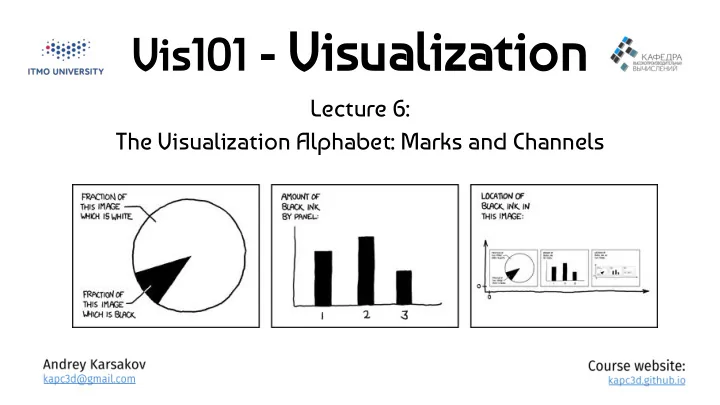

101 - Vi Visu sual aliz izat atio ion Vis is10 Lecture 6: The Visualization Alphabet: Marks and Channels
This Week Homework 1! Lecture 5: Lecture 6: Section 2: Reading:
No Device Policy
Last Week
Terms Dataset Types Data Types
Tables Attributes Flat Table Keys Values Item Multidimensional Table
Multidimensional Tables Keys: Patients Keys: Genes z
Graphs/Networks
Fields Attribute values associated with cells Cell contains data from continuous domain Measured or simulated Sampling & Interpolation
Other Collections Sets Lists Clusters
Data Types Nominal (labels) Ordinal (ordered) Interval (location of zero arbitrary) Ratio (zero fixed) On the theory of scales and measurements [S. Stevens, 46]
Item/Element/ (Independent) Variable
Attribute/ Dimension/ (Dependent) Variable/ Feature
Semantics
Keys?
Attribute Types?
Categorical Ordinal Quantitative
Design Critique
Recalled Cars NY Times http://goo.gl/tDVISB
The Visualization Alphabet: Marks and Channels
Marks & Channels
Example: Homework 2
Marks for Items
Marks for Links
Containment can be nested
Channels (aka Visual Variables)
Jacques Bertin
Bertin’s Visual Variables
Using Marks and Channels
Redundant encoding
Good bar chart?
Types of Channels
Channels: Expressiveness Types and Effectiveness Ranks
What visual variables are used?
What visual variables are used?
Characteristics of Channels Selective Associative Quantitative (Magnitude vs Identity Channels)
Characteristics of Channels Order (Magnitude vs Identity) Length
Position Strongest visual variable Suitable for all data types Problems:
Example: Scatterplot
Position in 3D?
Length & Size Good for 1D, OK for 2D, Bad for 3D Easy to see whether one is bigger Aligned bars use position redundantly
Example 2D Size: Bubbles
Value/Luminance/Saturation OK for quantitative data when length & size are used. Not very many shades recognizable
Example: Diverging Value-Scale
Color Good for qualitative data (identity channel) Limited number of classes/length (~7-10!) Does not work for quantitative data! Lots of pitfalls! Be careful! Suggested rule:
Color: Bad Example
Color: Good Example
Shape Great to recognize many classes. No grouping, ordering.
Chernoff Faces Idea: use facial parameters to map quantitative data
More Channels
Why are quantitative channels different?
Steven’s Power Law, 1961
How much longer?
How much longer?
How much steeper?
How much larger (area)?
How much larger (area)?
How much larger (diameter)?
How much darker?
Position, Length & Angle
Other Factors Affecting Accuracy
Cleveland / McGill, 1984
Heer & Bostock, 2010
Jock Mackinlay, 1986
Channels: Expressiveness Types and Effectiveness Ranks
Next Week Lecture 7: Lecture 8: Section 3: Homework 1 due to Friday, 30 October.
Recommend
More recommend